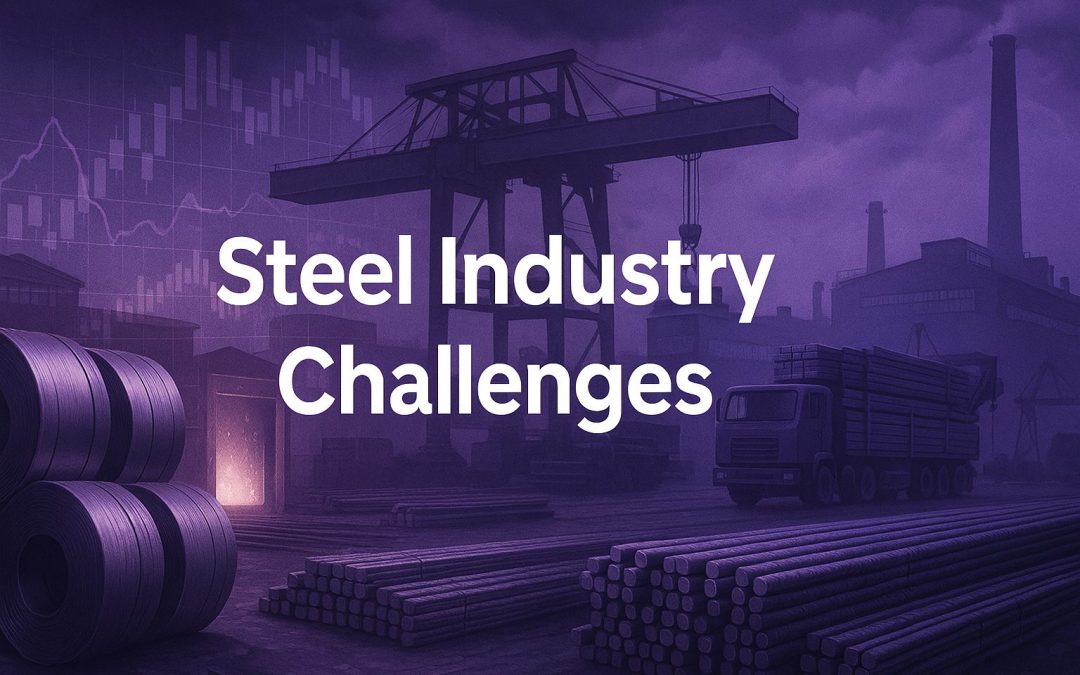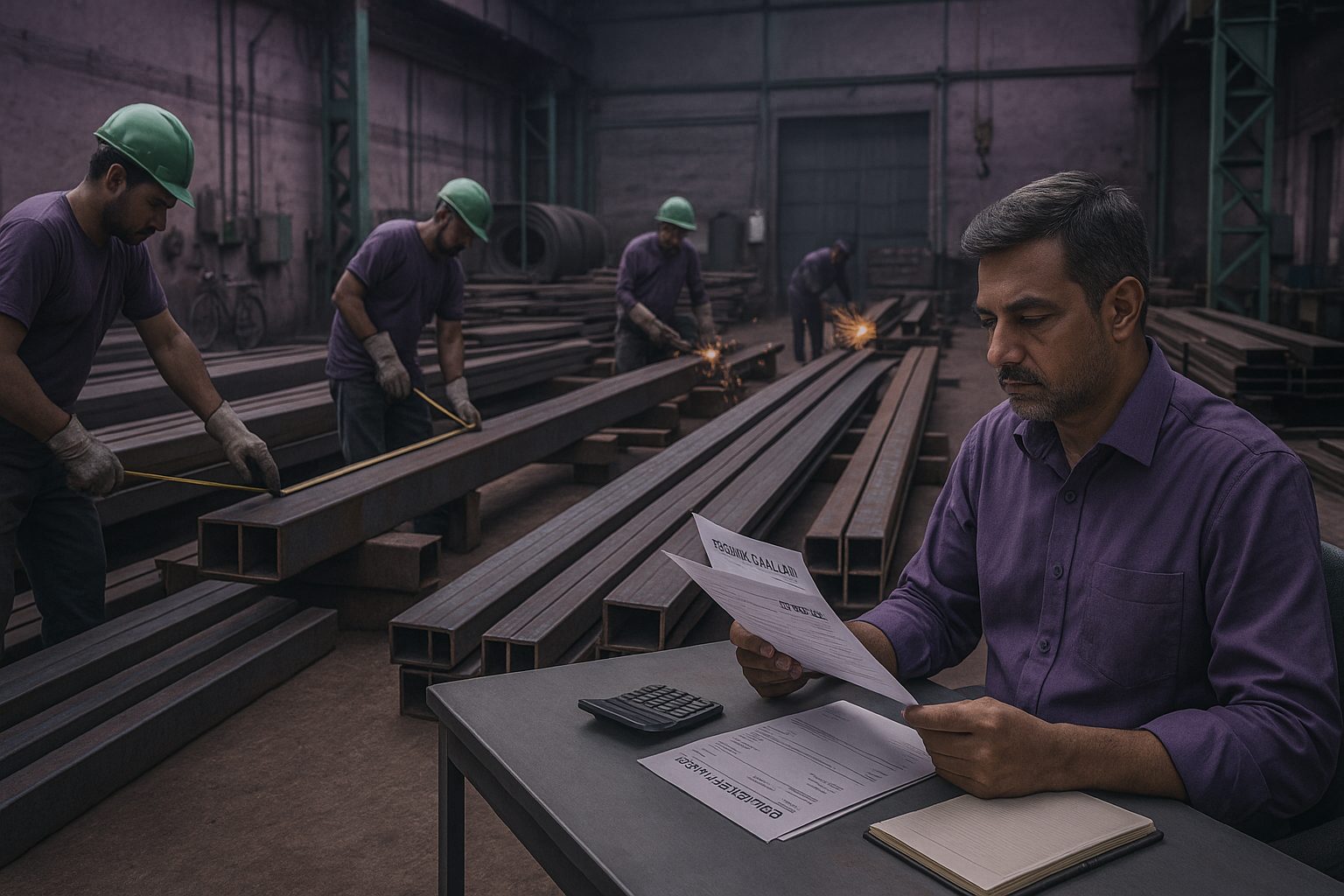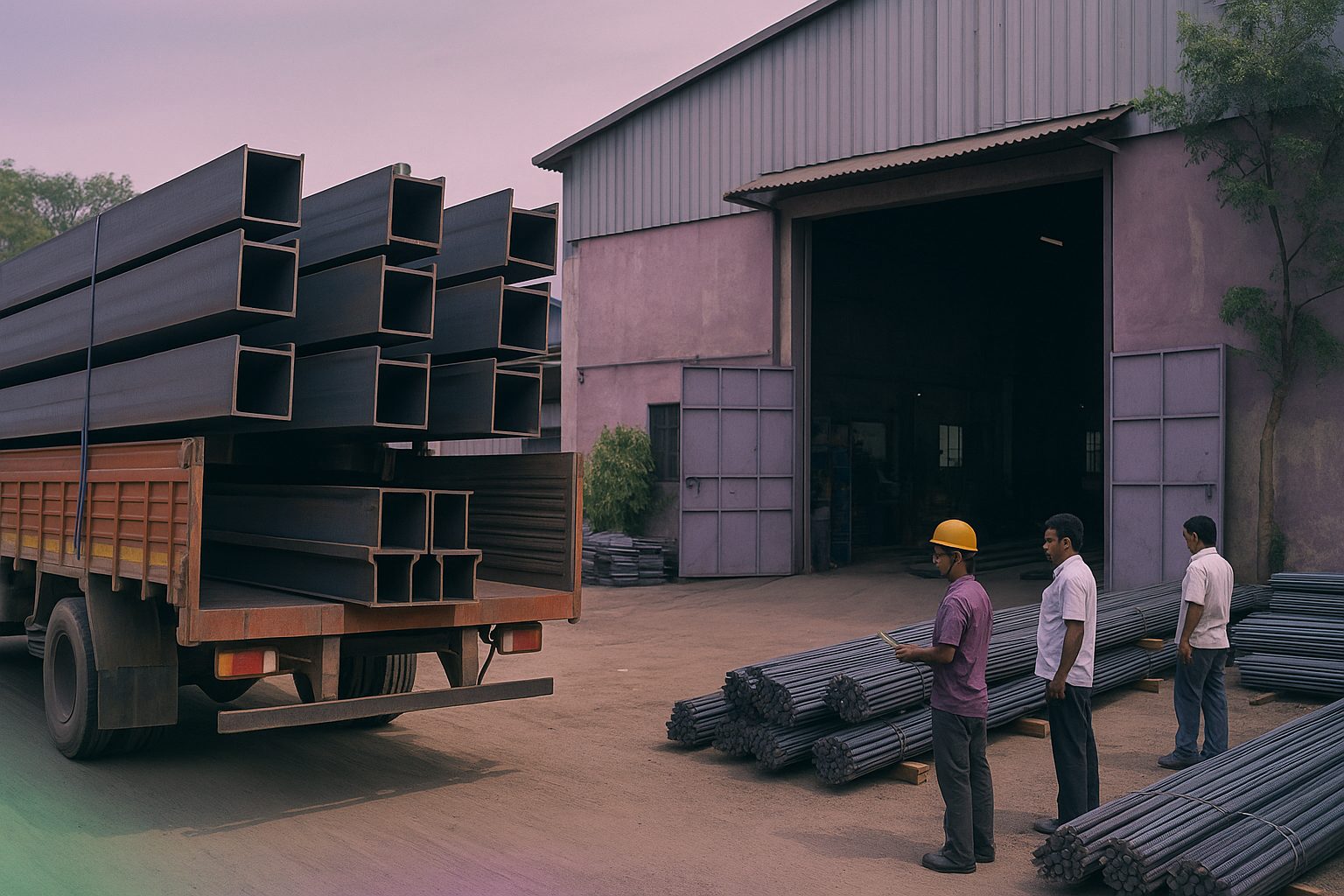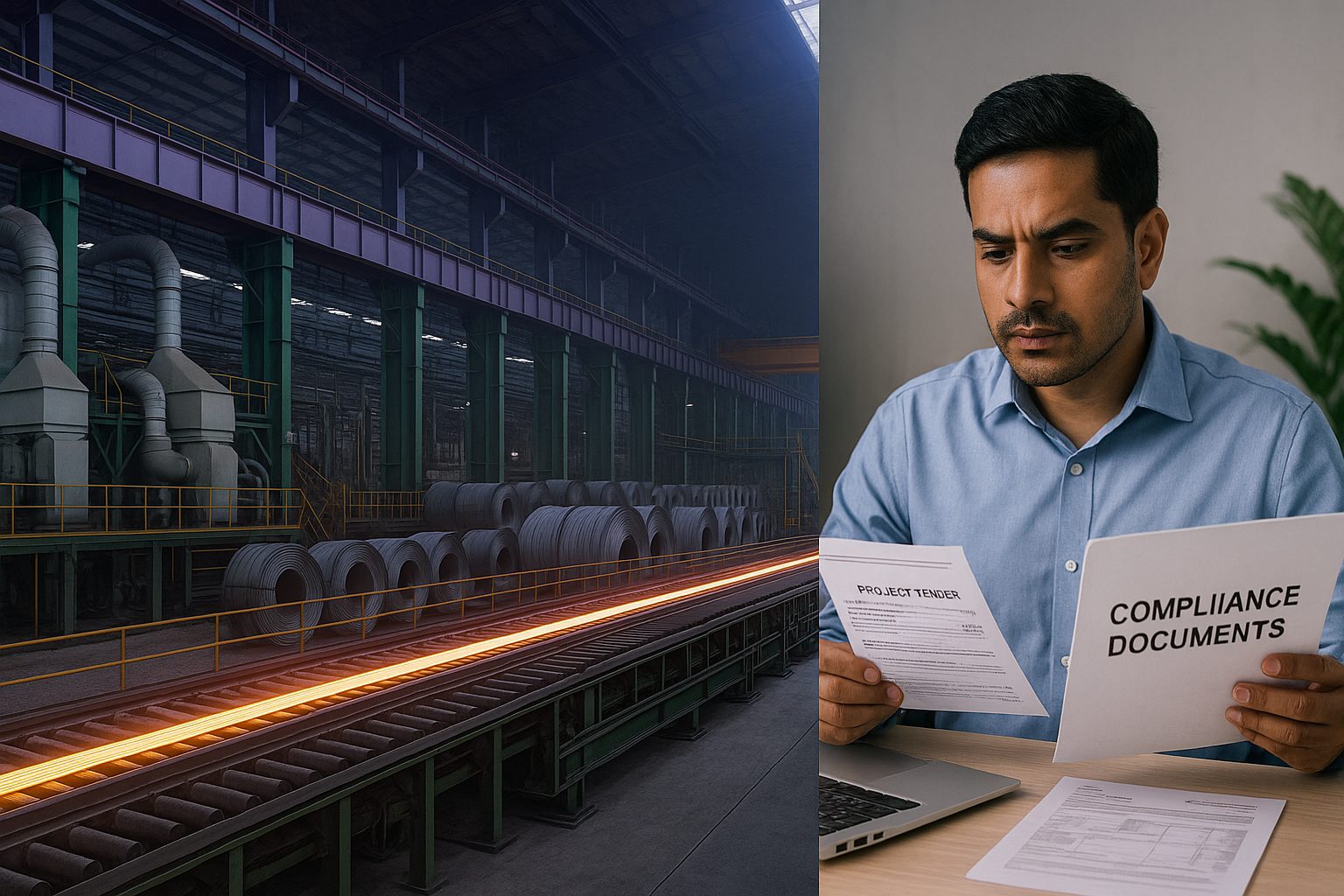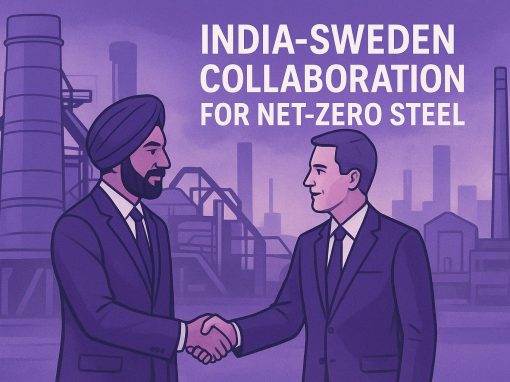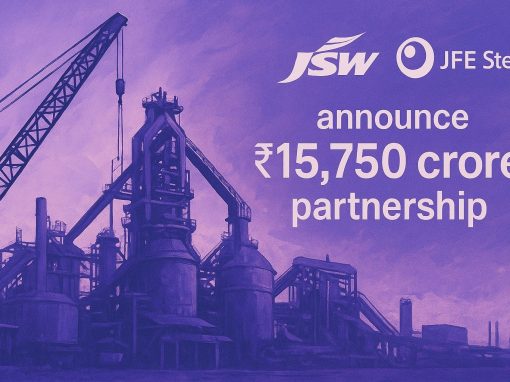Table of Contents
Introduction
Steel sits at the heart of India’s industrial work. It is used in bridges, factory sheds, machines, storage tanks, engineering parts and everyday fabrication jobs carried out by small businesses. India has grown into the second-largest steel producer, and policy targets point toward even higher capacity in the coming years. Yet growth does not erase the structural hurdles, basically steel industry challenges, that still shape how steel is made, moved and sold in the country.
For MSMEs, these challenges are not abstract. And these show up in day-to-day operations:
- A sudden jump in steel prices can wipe out the margin on a confirmed order.
- A delayed truck can bring a workshop floor to a standstill.
- Unclear paperwork surely slow payments from large buyers/ government departments.
- Limited supplier options often force MSMEs to accept unfavourable terms.
Most small manufacturers, fabricators, contractors, etc. work, with tight delivery windows and restricted cash flow. And even a small disruption can lead to a chain reaction, from production delays to penalty risks. Thus, understanding the in-depth the steel landscape will help businesses plan better, negotiate smarter and avoid last-minute surprises.
This article explains eight major challenges affecting the steel industry in India and connects each one to what it means for MSME buyers. The aim is practical: give business owners and purchase teams clearer insight so they can make informed sourcing and planning decisions.
Capital and labour intensive industry
So, do you know what does steel manufacturing demands? It requires large plants, complex machinery, steady capital, and so on. Even setting up a mid-sized facility takes significant investment and also years of planning. The industry also relies on a sizeable workforce for mining, processing, furnace operations and quality control. This combination of high cost and labour dependence limits the number of producers and keeps the sector concentrated.
For MSMEs, this structure creates practical constraints:
- When supply is controlled by a few large mills, pricing becomes less flexible.
- Any production slowdown or maintenance shutdown quickly affects availability.
- Credit terms often tighten because producers must recover high capital costs.
An MSME may not feel these issues at the factory gate, but they show up in everyday procurement. A stockist may reduce credit days or raise minimum order quantities. A fabricator may have to wait longer for a particular grade because production capacity is booked in advance. Working capital pressure grows when upfront payment is demanded during price peaks.
Some MSMEs manage this risk through supplier diversification, scheduled buying or working with service centres that offer smaller lot sizes and cut-to-length options. These steps do not solve the system-level challenge, but they help maintain continuity in production and dispatch.
Demand prediction
Steel consumption in India moves with the pace of construction, infrastructure and manufacturing activity. These sectors do not grow evenly, that’s why demand oftentimes swings without many warnings. On the contrary, large projects can definitely create sudden spikes, and the policy delays or global slowdowns can cause sharp drops. Producers struggle to align output with these shifts, and that can lead to either surplus stock or supply tightness. For MSMEs, this unpredictability complicates planning:
- Prices can rise between order confirmation and raw material purchase.
- Fabricators quoting fixed rates in tenders can definitely face margin risk when steel becomes costlier.
- Buyers with limited storage space cannot always stock material in advance.
In real procurement cycles, timing matters as much as rate negotiation. A workshop that depends on just-in-time buying can lose a week of production if material is unavailable. On the other hand, over-buying during a high-price phase can lock up working capital and reduce flexibility on future orders. The same uncertainty affects project-based MSMEs supplying EPC contractors, where delay penalties sit alongside rising steel costs.
Consequently, some businesses monitor price trends, check multiple suppliers, split orders across weeks to balance exposure, and so on. However, others include price-variation clauses in contracts to avoid absorbing all risk. These are not perfect solutions, but they help MSMEs stay resilient when demand cycles turn unpredictable.
Logistics related challenges
Steel is a bulk material that requires careful handling from mill to buyer. Most movement depends on railways for long distances and trucks for last-mile delivery. Rail capacity is limited, loading can be delayed, and wagon availability is often uncertain. Road transport, though flexible, can become costly due to fuel prices, tolls and poor highway stretches. For mills located far from ports or mining belts, these constraints add both time and expense.
For MSMEs, logistics challenges surface in everyday operations, as follows:
- A truck delayed by a day can halt cutting, welding or assembly work.
- Damage during transit forces rework or rejection of material.
- Freight charges vary widely, making the real landed cost hard to predict.
Many small units work with tight project schedules. A missing heat number or late delivery can affect dispatch deadlines and trigger penalty clauses from larger buyers. In high-demand periods, transporters may prioritise bigger consignments, leaving MSME orders waiting longer at the yard. Even when material arrives, unloading can be difficult if the workshop lacks proper equipment, increasing the risk of bends, dents or wastage.
To reduce uncertainty, some MSMEs buy from nearby stockyards instead of directly from mills. Others factor freight into every quote, compare door-delivery options, or insist on documented handovers at dispatch. These small steps can save both downtime and cost in a supply chain that remains unpredictable.
Disruptions in raw material supply
Disruption in supply of raw materials is yet another problem faced by the steel industry in India. Steel production depends heavily on two key raw materials (inputs): iron ore and coking coal. Although, India has substantial reserves of iron ore, on the other hand, high-grade coking coal is largely imported. And, global market shifts, trade restrictions, port congestion, geopolitical tensions, etc., directly impact coal supply and make it unpredictable. Apart from it, when coal becomes scarce or expensive, mills face rising production costs and even unpredictable output schedules. This for businesses may lead to upstream disruption. And it is felt as sudden jumps or reduced availability of specific grades.
- Standard IS-grade material may be found in limited stock and at higher prices by a fabricator.
- A switch of suppliers mid-project may be forced upon a small engineering unit, affecting quality consistency.
- Cost spikes are often absorbed without support by buyers with fixed delivery commitments.
In real procurement cycles, price lists can be changed within days due to raw material volatility. Credit may be restricted or immediate payment may be insisted upon by stockists when market signals turn unpredictable. In addition, businesses that rely on a single distributor or purchase only when orders arrive are hit harder, as alternate supply takes time to secure.
That’s why, businesses track coal and iron ore trends. And this is not to speculate, but to anticipate ripple effects. While others plan staggered buying or negotiate partial advance locking of rates. These steps do not solve the broader supply issue, but they help MSMEs avoid panic buying and reduce exposure when raw material disruptions spread through the chain.
Low per capita consumption
India has emerged as a leading steel producer, yet domestic consumption is still recorded as lower than global benchmarks.Per capita steel use in India is still well below the world average, and far behind countries like China. This limits the depth of local demand and places pressure on producers to rely more on export markets or cyclical infrastructure spending. When domestic demand does not grow steadily, capacity goes underused and pricing becomes more volatile.
For MSMEs, this slow consumption growth has indirect effects:
- Regional availability can vary, forcing buyers to depend on distant stockists.
- Price drops during low-demand cycles may seem attractive, but they often come with reduced supply reliability or limited grade options.
- Smaller players may struggle to access material when mills prioritise larger industrial buyers or export contracts.
In project-driven markets, MSMEs often align their procurement with infrastructure activity or seasonal manufacturing cycles. When demand lags, mills may cut production or adjust their product mix, making it harder to source specific thicknesses or specialty steels. This creates unexpected delays even when headline prices appear favourable.
Moreover, businesses handle this challenge by stocking essential sizes, tracking regional demand trends, planning purchases around public spending announcements, etc. Apart form it, they even stay alert to demand patterns, they are better prepared to navigate the uneven pace of steel consumption in the country.
Lack of technology adoption
It’s true that digital systems have transformed many industries, still adoption in steel remains uneven. Many large integrated plants have automated processes, real-time inventory systems, quality tracking tools, and so on. On the other hand, smaller mills, re-rollers and stockists often operate on manual records, phone-based ordering, basic spreadsheets, etc. Thus, it can be said that this gap slows information flow and reduces transparency in the supply chain.
Hence, for businesses, this lack of digital maturity has clear consequences, which includes:
- Delivery timelines are oftentimes updated verbally, and, not through live tracking.
- Quality certificates may arrive late or with incomplete details.
- Buyers struggle to verify grade consistency across multiple heat numbers.
In real procurement workflows, a missing test certificate can delay billing or inspection clearances. A workshop waiting for dispatch confirmation may have welders standing idle. In addition, manual processes also leave room for mistakes, especially when orders involve multiple thicknesses, shapes or coatings. And without digital traceability, to resolve such disputes become impossible over short delivery or damaged bundles.
Thus, most of the businesses are beginning to use online platforms to compare offers, track orders, access documents in one place, etc. While others rely on suppliers that have adopted ERP systems or provide digital proof of delivery. These shifts are gradual, but they help smaller businesses gain visibility, reduce follow-up calls and avoid paperwork delays.
Downtime and capacity use
Steel plants are expensive to run, even when production slows down. What if raw materials don’t arrive on time or transport is disrupted or power supply is unstable? Even mills cannot operate at full capacity, then what will happen? The answer is simple, their fixed costs stay the same, but they produce fewer tonnes. Eventually, pushing up the cost per unit. Over time, this makes it harder for steel makers to keep prices competitive or invest in better technology.
MSMEs feel this pressure in two different ways:
- When mills are running below capacity, they often cut prices to clear inventory. This helps buyers – but only for a short while.
- When demand picks up and production is back at full speed, prices rise fast, and smaller buyers are the first to face the squeeze.
Since MSMEs usually work with tight margins, this swing can be risky. A fabricator quoting a project at a steady rate may suddenly see profits disappear if steel prices surge. On the other hand, when prices drop, stock may be available – but not always in the right grades, timelines or quality levels.
Many smaller businesses now plan their purchases more smartly. Some split orders instead of buying in one go. Others lock part of the volume at flexible rates, so they’re not exposed to a single price point. These steps don’t remove risk completely – but they do offer more control in an uncertain market.
Rising focus on sustainability
Steel production uses a lot of energy, and the sector is under increasing scrutiny for its emissions. What exactly is happening though? So, governments, global climate agreements, large buyers, etc. are now pushing the industry so that it can also adopt cleaner processes. This shift is crucial, but it also adds cost and regulatory pressure. And for older or smaller mills, the impact is significant; as they don’t have the funds to upgrade quickly. For MSMEs, these environmental changes are beginning to influence how steel is sourced:
- Big manufacturers and export clients now ask for proof of where the steel comes from and how it was made.
- Some tenders include conditions like low-emission steel or certified sourcing.
- Furthermore, costs for pollution control and eco-friendly steel may gradually show up in prices.
This trend is still developing, but it’s already changing the rules of procurement. MSMEs that work with premium or global customers may be asked for more detailed documentation – not ust test certificates, but proof of furnace type, plant origin or emission levels. And in case you might miss these details then it can impact on approvals or even knock a supplier out of the shortlist.
To stay ready, some small businesses are improving their paperwork, sourcing from trusted mills, or choosing vendors that meet newer environmental norms. The full transition will take time, but early preparation can help MSMEs avoid last-minute compliance issues and stay competitive in future tenders.
Also read: How to reduce the carbon footprint of steel?
Conclusion
The steel sector is changing, but many of its challenges are the same — high costs, complex supply chains and market volatility. But, this is not the end. These issues don’t just impact large mills, but they even shape how MSMEs source, finance, store and use steel every day. And hence, a delay in delivery or a sudden price jump can directly impact production as well as profitability.
Additionally, this is true that businesses can never control global prices or policy shifts, but what’s in their control is: how they buy and plan things. So, choosing multiple suppliers, keeping track of shipments, aligning purchases with project timelines, etc. help reduce the risk. Knowing the market better also prevents rushed buying decisions.
Today, with digital platforms and more organised steel networks, small businesses have better access and visibility than before. By staying informed and flexible, MSMEs can handle uncertainty and turn it to their advantage – because in this market, every rupee and every delivery matters.
Also read: Steel industry and stock market
Looking to procure steel?
Tata nexarc helps manufacturers, builders and MSMEs source certified steel products, compare prices, and choose the right grade as per IS codes—with complete traceability and procurement confidence.
FAQs
How can a business owner lock steel prices when there is market volatility?
What is the minimum lot size most stockists expect from MSME buyers?
Which documents are essential for commercial steel buying?
Can MSMEs buy directly from steel mills?
Why do steel distributors ask for immediate payment after dispatch?
What is the safest way to manage steel buying for multiple ongoing projects?
Can sustainability demands increase steel cost for MSMEs?
Why do some tenders reject steel supplied by MSMEs?
How can fabrication MSMEs avoid rework due to steel defects?
Are digital steel platforms reliable for MSME procurement?
Swati is a passionate content writer with more than 10 years of experience crafting content for the business and manufacturing sectors, and helping MSMEs (Micro, Small and Medium Enterprises) navigate complexities in steel procurement, and business services. Her clear and informative writing empowers MSMEs to make informed decisions and thrive in the competitive landscape.
